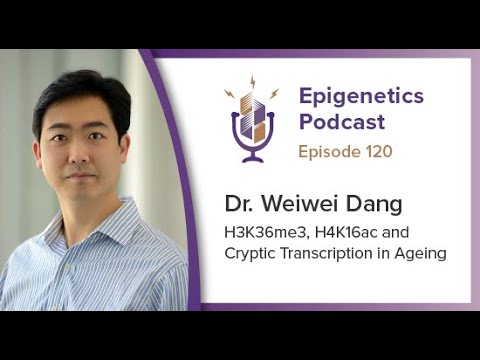A prevalent feature described during aging is the overall reduction in heterochromatin, specifically marked by the loss of repressive histone modification, Histone 3 lysine 9 trimethylation (H3K9me3). However, the role of H3K9me3 in aging, especially in mammals, remains unclear. Here we show using a novel mouse strain (TKOc), carrying a triple knockout of three methyltransferases responsible for H3K9me3 deposition, that the inducible loss of H3K9me3 in adulthood results in premature aging. TKOc mice exhibit reduced lifespan, lower body weight, increased frailty index, multi-organ degeneration, transcriptional changes with significant upregulation of transposable elements, and accelerated epigenetic age. Our data strongly supports the concept that the loss of epigenetic information directly drives the aging process. These findings reveal the importance of epigenetic regulation in aging and suggest that interventions targeting epigenetic modifications could potentially slow down or reverse age-related decline. Understanding the molecular mechanisms underlying the process of aging will be crucial for developing novel therapeutic strategies that can delay the onset of age-associated diseases and preserve human health at old age specially in rapidly aging societies.
Excessive methylation of DNA triggers aging because it disrupts the correct reading of DNA. There has been a lot of work lately on enzymes that remove methylation from DNA.In this respect, the effects of aging are being tried to be reversed with newly developed demethylase enzymes.
Good thing Rapamycin as an mTOR inhibitor improves many of the histones youthful modifications with even a short duration of administration. At least in older mice.
The remaining compounds, TCP and Repsox, met the selection criteria for chemical reprogramming functional categories and were thus selected. Therefore, we next treated aged human fibroblasts with this reduced two-chemical cocktail (2c) for 6 days to determine its effect on aging hallmarks. Strikingly, similar to our previous results with 7c, γH2AX levels were significantly decreased upon 2c treatment (Fig. 3a). Furthermore, improvement on yH2AX levels was observed when cells were treated with 2c following addition of the DNA damaging agent doxorubicin (Fig. S3b). Moreover, 2c significantly increased both H3K9me3 and H3K27me3 levels (Fig. 3b-c). Taken together, these data indicate that 2c treatment improves DNA damage and heterochromatin marks similar to 7c treatment.
Overall, these results show that the reduced 2c cocktail is able to improve multiple age-related hallmarks including genomic instability, epigenetic dysregulation, and cellular senescence. Importantly, treatment with 2c had a minor effect on proliferation and led to a decrease in ROS levels. Taken together, these data indicate that 2c is an optimized cocktail capable of improving multiple age-related markers in vitro.
Finally, in order to determine whether our 2c cocktail could also impact biological aging in vivo, we tested the effect of 2c treatment on the lifespan of a commonly used aging model organism, the nematode Caenorhabditis elegans. Towards this goal, we monitored survival in C. elegans treated with either 2c, Repsox, or TCP at three different concentrations (50, 100, or 200 μM) alongside a vehicle control. Strikingly, we observed that 2c treatment at 50 μM was sufficient to extend C. elegans median lifespan from 19 to 27 days, corresponding to a 42.1% increase relative to vehicle control (Fig. 4a, e). To a lesser extent, Repsox or TCP alone at 50 μM also increased C. elegans median lifespan to 25 days, a 31.6% increase over vehicle control (Fig. 4a, e). These results indicate that Repsox and TCP are each able to extend median lifespan in C. elegans, and when combined as part of the 2c cocktail, can lead to an even greater increase in median lifespan.
In contrast, H3K27me3 and H3K9me3 levels were inversely correlated with KDM1A levels.
Tranylcypromine (Parnate) will increase the levels of H3K27me3 and H3K9me3, even when used alone.
Epithelial to mesenchymal transition, EMT, is a paradigm of cell plasticity that it is characterized by reversible loss of epithelial characteristics and acquisition of mesenchymal properties. During EMT transition a global H3K9me2 reduction and H3K4me3 and H3K36me3 increase have been observed. These changes have been found to be largely dependent on LSD1 activity and loss of LSD1 function has marked effects on EMT-driven cell migration and chemoresistance.
Here, we show that Drosophila photoreceptors undergo an age-associated decrease in two histone methylation marks associated with active transcription: H3K4me3 and H3K36me3. These age-dependent decreases in histone methylation were observed at all actively expressed genes and did not correlate with differential gene expression or chromatin accessibility.
https://www.nature.com/articles/s41598-023-32273-5
The levels of H3K36 trimethylation (H3K36me3) decreased as cells age, commensurate with a genome-wide increase in intragenic cryptic transcription in old cells. This is consistent with the function of H3K36me3 in suppressing such cryptic transcription mediated through deacetylation of histones in gene body by recruiting histone deacetylase complex RPD3S. Deleting components of RPD3S shortened lifespan, supporting this model. The increased levels of cryptic transcription were suppressed by RPH1 deletion, suggesting that its longevity effect is mediated by improved genome-wide control of cryptic transcription. Furthermore, increases in intragenic cryptic transcription were also detected in aged C. elegans and mammalian cells. Knocking down the H3K36me3 demethylase JMJD-2 extended worm lifespan. Finally, decreased levels of H3K36me3 and increases in H3K4me1, H3K27ac, and RNA polymerase II were detected toward the 3’-ends of genes showing age-associated cryptic transcription in human mesenchymal stem cells.
Epigenetics Podcast #120 - H3K36me3, H4K16ac and Cryptic Transcription in Aging
